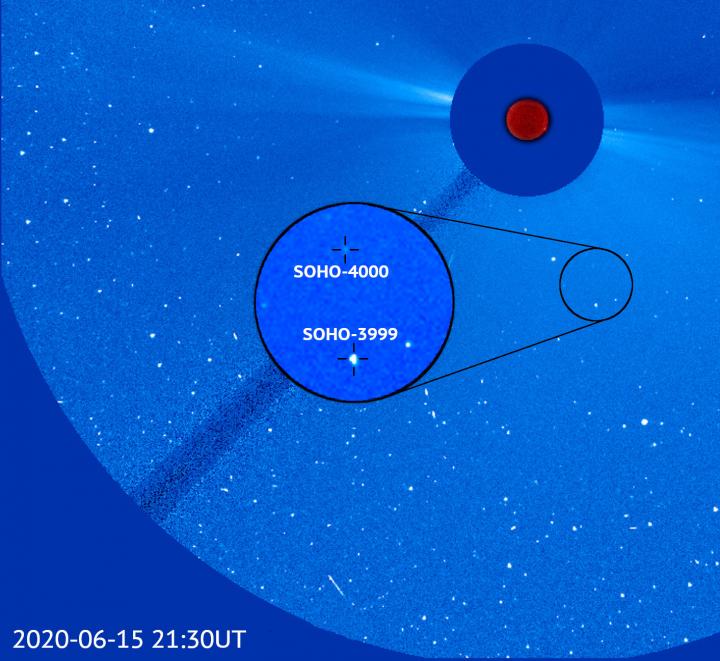NRL telescope onboard ESA, NASA SOHO discovers 4000th comet

The 4,000th comet discovered by ESA (European Space Agency) and NASA's SOHO observatory is seen here in an image from the spacecraft alongside SOHO's 3,999th comet discovery. The two comets are relatively close at approximately 1 million miles apart, suggesting that they could have been connected together as recently as a few years ago. Credit: ESA/NASA/SOHO/Karl Battams
LASCO, which is aboard SOHO, was developed in 1995 to see the extremely faint emission from the region around the Sun called the corona. Operating in space for nearly 25 years, the telescope has seen much more space action than researchers originally anticipated — discovering well over half of all known comets.
“In less than 25 years SOHO has added this huge volume to the archives of our comet knowledge, and it comes from a telescope not designed to see comets,” said Karl Battams, NRL computational scientist.
“This is exciting for many reasons, but perhaps mostly because LASCO is discovering comets that are otherwise completely unobservable from Earth due to their proximity to the Sun.”
The majority of the comet discoveries were made by amateur astronomers who participated in the NASA-funded and NRL-managed Sungrazer project, which encourages citizen scientists to peruse imagery from SOHO and the Sun-Earth Connection Coronal and Heliospheric Investigation (SECCHI) instrument suite on the NASA Solar Terrestrial Relations Observatory (STEREO) and search for previously unknown comets. New comet findings are reported through the website, and subsequently verified and measured by Battams, who has led this Project since 2003.
“The people who discovered these comets were not necessarily professional astronomers, they were people at home,” Battams said. “People of all ages, backgrounds, and countries have volunteered their time to be a part of this citizen science project. The 4000th comet is a testament to the invaluable input from so many volunteers all around the world over the past two decades.”
The Navy has a unique interest in the Sun and near -Sun environment. Much of the Navy's equipment, and equipment we use every day, such as GPS, is impacted by the Sun. Studying comets traveling near the Sun helps researchers gain a greater understanding of Earth's closest star, as they observe the comets reacting to its extreme environment.
Battams is a computational scientist and astrophysicist within the Solar and Heliospheric Physics Branch under the Space Sciences division at NRL. The mission of this Branch is to develop improved heliospace environment understanding, awareness, sensors, forecast capabilities, and monitoring tools that predict operational impacts and enable real-time threat warning; and transition these developments to support the Navy/Marine Corps and other agencies.
###
About the U.S. Naval Research Laboratory
NRL is a scientific and engineering command dedicated to research that drives innovative advances for the Navy and Marine Corps from the seafloor to space and in the information domain. NRL is located in Washington, D.C., with major field sites in Stennis Space Center, Mississippi; Key West, Florida; and Monterey, California, and employs approximately 2,500 civilian scientists, engineers and support personnel.
Media Contact
All latest news from the category: Physics and Astronomy
This area deals with the fundamental laws and building blocks of nature and how they interact, the properties and the behavior of matter, and research into space and time and their structures.
innovations-report provides in-depth reports and articles on subjects such as astrophysics, laser technologies, nuclear, quantum, particle and solid-state physics, nanotechnologies, planetary research and findings (Mars, Venus) and developments related to the Hubble Telescope.
Newest articles

Sea slugs inspire highly stretchable biomedical sensor
USC Viterbi School of Engineering researcher Hangbo Zhao presents findings on highly stretchable and customizable microneedles for application in fields including neuroscience, tissue engineering, and wearable bioelectronics. The revolution in…

Twisting and binding matter waves with photons in a cavity
Precisely measuring the energy states of individual atoms has been a historical challenge for physicists due to atomic recoil. When an atom interacts with a photon, the atom “recoils” in…

Nanotubes, nanoparticles, and antibodies detect tiny amounts of fentanyl
New sensor is six orders of magnitude more sensitive than the next best thing. A research team at Pitt led by Alexander Star, a chemistry professor in the Kenneth P. Dietrich…





















